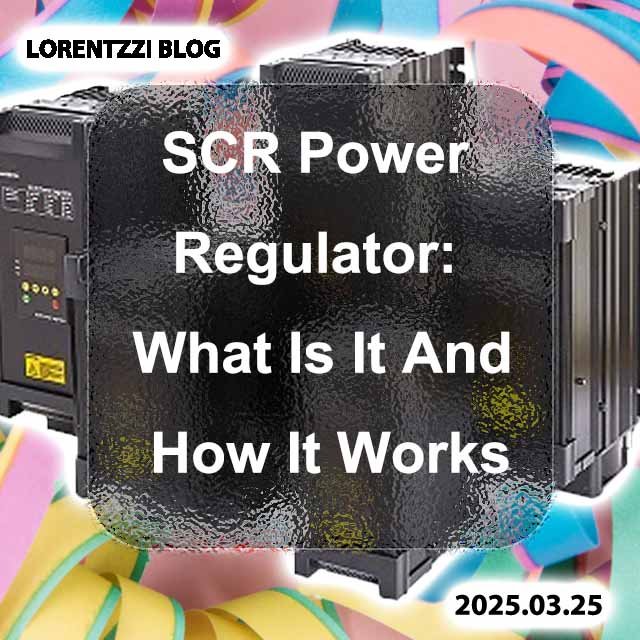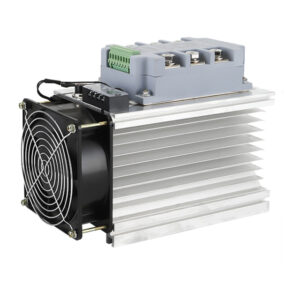SCR power regulator is also called thyristor power controller. This product may not be common in our daily life, but as an important component in the field of industrial production, especially in the field of temperature control, it is widely used.
So in today’s blog, we will explain what it is and how it works among other things, now let’s get started.
What is an SCR power regulator?
Similar to a solid-state relay with no moving parts, an SCR power regulator is a semiconductor electronic device that is commonly used to control the power output of resistive heaters in ovens, furnaces, and dryers.
The output of the SCR power regulator is continuous and can adjust the output power in real time according to the control signal to meet the load demand. At the same time, it is usually equipped with a feedback system to ensure that the output power remains stable when the load or input voltage changes.
What is an SCR?
SCR stands for Silicon Controlled Rectifier, which is a semiconductor that acts as a switch to control the power supply to the heating element. We will explain it in detail in the next section.
SCR consists of four semiconductor layers, forming three PN junctions. There are usually three lead electrodes: anode (A), cathode (K) and gate (G).
Its working principle is very simple, that is, when a forward voltage is applied between the anode(A) and cathode(K), it will not directly conduct. It will only conduct when a suitable voltage is applied to the gate(G). At this time, even if the gate voltage is removed, the anode and cathode will still remain conductive. The only condition that can stop it from conducting is the voltage reversal or the power supply is stopped. This characteristic makes SCR very suitable for controlling DC or AC power.
Control methods of an SCR power regulator
The main control methods of SCR power regulators can be divided into two types: phase shift control and zero crossing control. The following is a detailed introduction to these two control methods:
Phase shift control: This method changes the conduction angle of the SCR in the positive and negative half cycles of each sine wave to control the output power. It can achieve continuous regulation of output voltage and current.
Zero crossing control: In a set time period, the average power on the load is adjusted by controlling the on-off time ratio of the SCR. This method is usually used in situations where electromagnetic interference needs to be reduced.
The waveforms of the output voltages of these two control methods are as follows:

Regardless of whether phase shift control or zero-crossing control is used, a zero-crossing detection circuit is generally used. The circuit is as follows:

Its output waveform will be like following:

How to control an SCR power controller?
Same as our Lorentzzi brand solid-state voltage regulator, the SCR power regulator is also controlled by an analog signal. This signal can be generated by a PID temperature controller with 4-20 mA or 0-10 VDC output or PLC(Programmable Logic Device), or it can be controlled by a manually operated potentiometer.
The difference between the SCR power regulator and our solid-state voltage regulator is that the solid-state voltage regulator can only handle small currents, usually less than 120 amps, while the SCR power regulator can control much larger currents, up to 1000A or more.
Additionally, our solid-state voltage regulator lacks a feedback mechanism, so it cannot automatically adjust to voltage fluctuations.
Types of SCR power regulator
SCR power regulators are classified into single-phase and three-phase according to the voltage difference they control.
The single-phase SCR power regulator is used to control the single-phase low-power heater, and the three-phase SCR power controller is used to control the three-phase high-power heater.
How to choose a right SCR power regulator for your heater
Now we have a rough understanding of the SCR power regulator, but how do we correctly choose the right SCR power controller? In the following section, I will teach you step by step.
1. Check your heater is single phase or 3 phase:
Before selecting an SCR power conditioner for your heater, confirm whether your heater uses single-phase or three-phase power.
Single-phase heaters must be paired with single-phase SCR power conditioners, while three-phase heaters require three-phase SCR power controllers.
Using the wrong type of regulator can result in serious consequences, such as fire or electric shock. For example, using a three-phase SCR power conditioner to control a single-phase heater can upset the balance of the three-phase electrical system, causing instability and potential damage.
2. Select the output current of the SCR power regulator:
For example, if your heater is single-phase and rated at 10 kW, use this formula to calculate the current required: 10000/220/0.8=56 amps, so you need a single-phase SCR power regulator with a 60 amp output.
If your heater is three-phase 10 kW, the formula is 10000/380/1.732/0.8=19 amps, so you need a three-phase SCR power controller with a 20 amp output.
3. Select the control method:
As mentioned above, there are two control methods: phase shift and zero-crossing control.
If you do not want the heater to have a surge, try to use the zero-crossing control method; if you want more precise control, try to use the phase shift control method.
If you want to indirectly control the heater with a transformer, try to use phase shift control.
There are some other control methods, such as constant current and constant power, which are all achieved by phase shift control, but these two control methods are achieved through feedback mechanisms. Constant current or constant power control can reduce the impact of voltage fluctuations on the heater temperature.
4. Other functions to consider:
- Check whether a soft start function is needed. The soft start function can reduce the surge impact on the heater, thereby extending the service life of the heater.
- Check whether a current limiting or voltage limiting function is needed. Over current or over voltage will cause the heater to overheat, which will seriously affect not only service life of the heater but also accuracy of controlled temperature.
Conclusion

Lorentzzi® can provide not only economical open loop SCR power regulators, but also high precision closed loop SCR power regulators.
Our economical products are cheap, and our high precision products have feedback mechanisms, which can control the temperature more accurately to ensure safe production and greatly extend the service life of the heater.








